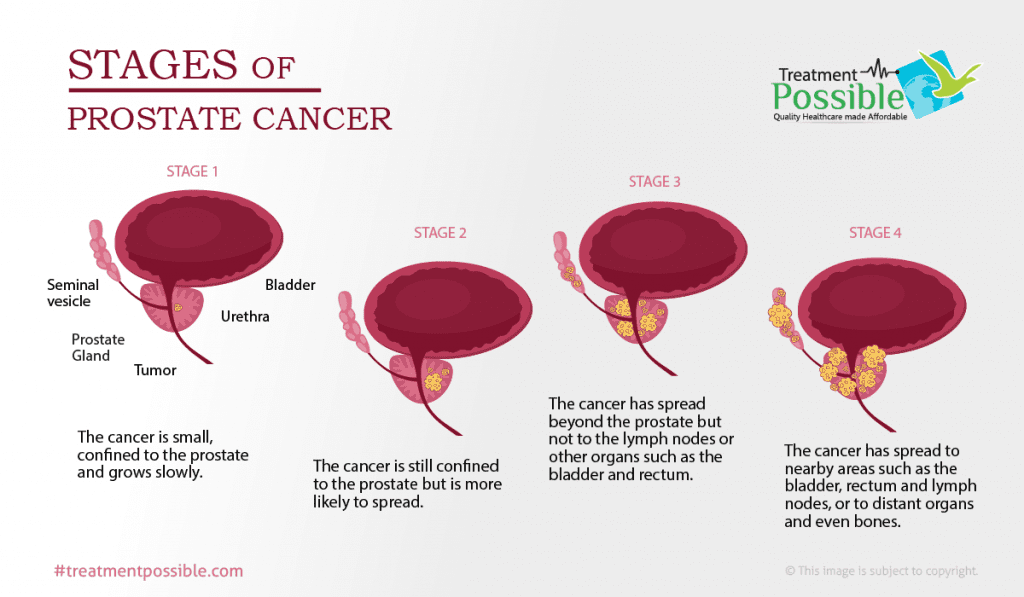About Prostate Cancer
Navigate To:
What is Prostate Cancer?
Prostate cancer is a common type of cancer in males, and it is only curable when detected in the early stages. The Prostate is a walnut-shaped gland that is located between the penis and the bladder. The prostate is regulated by the hormone testosterone and produces seminal fluid known as semen. Semen is the substance which contains sperm that exits the urethra during ejaculation.
The prostate has various functions that include:
- Producing fluid that nourishes and transports sperm
- Secreting prostate-specific antigen (PSA is a protein that helps semen retain its liquid state)
- Helps in controlling urine
Prostate cancer is when an abnormal, malignant growth of cells which is called a tumor forms in the prostate. This cancer can spread to other areas of the body and is still called prostate cancer. Prostate cancer is the most common cancers in men and is seldom detected early.

What are the Types of Prostate Cancer?
There are two types of prostate cancer are categorized by how fast they grow:
- Aggressive or fast-growing (it may spread to other areas of the body, such as the bones).
- Non-aggressive, or slow-growing
How does Prostate Cancer Develop?
DNA cells contain instructions for every chemical process in your body, but prostate cancer starts when prostate cells develop changes (mutations) in your DNA. The result is that cells may begin to grow out of control and eventually form a tumor that invades the nearby tissue. In some cases, abnormal cells can break away and spread (metastasize) to other parts of the body.
What are the Causes and Risk factors for Prostate Cancer?
The risk factors for prostate cancer include:
- Old age (prostate cancer is common in ages 45 to 65)
- Having a family history of prostate cancer
- Certain race — for instance, African American males are at greater risk of having prostate cancer
- Obesity
- Genetic changes
What are the Prostate Cancer Symptoms?
Some forms of prostate cancer are nonaggressive, so you may not have any symptoms in the early stages. However, advanced prostate cancer can cause signs and symptoms such as:
- Having a frequent urge to urinate (especially at night)
- Difficulty starting and maintaining urination
- Decreased force in the stream of urine
- Bleeding while urinating (hematuria)
- Painful urination
- Blood in the semen
- Bone pain
- Unintentional weight loss
- Erectile dysfunction
It is important to keep in mind that most of these symptoms can also be caused by other conditions that are not cancer. These conditions include benign prostatic hyperplasia (BPH) and prostatitis.
Important note: Metastatic cancer is cancer that has spread to other areas of the body from where it first occurred (it often spreads to the bones). This can cause pain in the pelvic, back and chest. In case cancer spreads to the spinal cord, you may lose feeling in your legs and bladder.
Are you facing any of the above Symptoms?
Consult an Experienced Doctor online for free
How is Prostate Cancer Diagnosed?
There are often no symptoms during the early stages of prostate cancer, but screening can detect changes that can indicate cancer. Therefore, men over 45 should undergo an annual medical examination which includes a rectal examination. However, the diagnoses will include the following:
- Prostate-specific antigen (PSA) test: This blood test detects your levels of PSA, a protein produced by the prostate. PSA level usually increases in prostate diseases.
- Digital rectal exam (DRE): Your doctor will insert a gloved finger into your rectum to inspect your prostate. They can feel if there are any hard lumps (button-like nodules) on your prostate gland (located toward the front of the rectum) that could be tumors. If any spots are found, further tests should be performed to determine if cancer cells are present.
- Transrectal ultrasound (TRUS) test: When the PSA or DRE indicates “an abnormality”, TRUS test is helpful for the doctor to decide if a biopsy is required or not. During a transrectal ultrasound, a small probe is inserted into your rectum and the probe uses sound waves to create a picture of your prostate gland. This test takes about 20 minutes.
- Urinary PCA3 test, MRI and CT scans are used before deciding whether to do a biopsy.
- Prostate biopsy: your doctor removes a small piece of your prostate gland for examination. If you had a prostate biopsy, you will receive a Gleason score. This score is used to classify the grade of prostate cancer cells. The grade indicates the aggressive growth of abnormal cells. A Gleason score lower than six means your cells do not show signs of cancer. If your doctor suspects your cancer may have spread beyond your prostate, then a bone scan and PET scan is suggested.
What are the Prostate Cancer Stages?
The stage of prostate cancer can help a person to understand what to expect, the stages would be as below:
- Stage 0: Precancerous cells are present, but they only affect a small area and are slow-growing.
- Localized (stage 1): Cancer is only present in the prostate gland. Effective treatment is possible at this stage.
- Regional (stages 2–3): Cancer has spread to nearby tissues.
- Distant (stage 4): Cancer has spread to other parts of the body, such as the lungs or bones.

